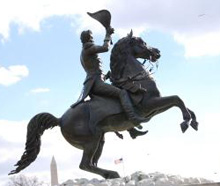 On a trip to the White House when I was six, I was convinced we were hopelessly lost when my grandfather kept driving past what seemed to me the same statue of a man on a horse. On my next trip, when I was older and a little more discerning, I discovered dozens of equestrian monuments, more, in fact, than in any other city in the United States.
On a trip to the White House when I was six, I was convinced we were hopelessly lost when my grandfather kept driving past what seemed to me the same statue of a man on a horse. On my next trip, when I was older and a little more discerning, I discovered dozens of equestrian monuments, more, in fact, than in any other city in the United States.
Following is a short list from a roster of more equestrian statues that visitors to this week’s inauguration festivities might see:
Ulysses S. Grant on Cincinnati in Union Square, at the east end of the Mall. According to biographer Jean Edward Smith, Grant “rarely permitted anyone to ride the horse, the exception being Lincoln, whom Grant considered an excellent horseman, and who rode Cincinnati whenever he visited the front.”
Andrew Jackson in Lafayette Park, Pennsylvania Ave. at Jackson Place, one block from the White House. Jackson’s statue (pictured), created in 1853 to commemorate his triumph over the British in the Battle of New Orleans (the last battle of the War of 1812), is the oldest full-scale equestrian sculpture in the U.S.
General William Tecumseh Sherman at the Treasury Place and Pennsylvania, near the White House. The statue is situated close to where Sherman watched the Review of the Union Army in May 1865, an event he referred to as one of the happiest and most satisfying in his life.
General Philip H. Sheridan at 23rd and Massachusetts NW. Considered to be one of the most dramatic of Washington’s equestrian monuments, the statue of Sheridan was sculpted by Gutzon Borglum, who later created the presidential memorials on Mount Rushmore. Sheridan is pictured atop Rienzi (also called Winchester), whose mounted remains are on view at the Smithsonian’s American History Museum.
George Washington at Washington Circle and Pennsylvania Ave., as well as next to the National Cathedral. The statue of Washington at the National Cathedral was created by Hebert Haseltine for a patron who requested that the nation’s first president be depicted riding Man O’War.
General Winfield Scott at Scott Circle and Massachusetts, as well as the Soldiers’ Home. Scott is the only Civil War general with two statues in Washington. The Soldiers’ Home monument was a subject of controversy even before it was cast in bronze, partly because of the size of the horse in relation to the portly Scott. Scott’s favorite mount had been a small mare, but critics thought he should be portrayed riding a stallion. Sculptor Henry Kirke Brown obliged by adding genitalia to the small horse with the head and body of a mare, which created even more controversy.
General George B. McClellan at DuPont Circle and Connecticut Ave, one and a-half miles from the White House. Dismissed after he let the Confederates retreat following the Battle of Antietam, McClellan had been Commander of the Army of the Potomac and General in Chief.
Joan of Arc in Meridian Hill Park at Florida Ave. and 16th NW. The statue of Joan of Arc, a gift from the women of France to the women of the U.S. in 1922, is the only equestrian monument in Washington with a female rider.
